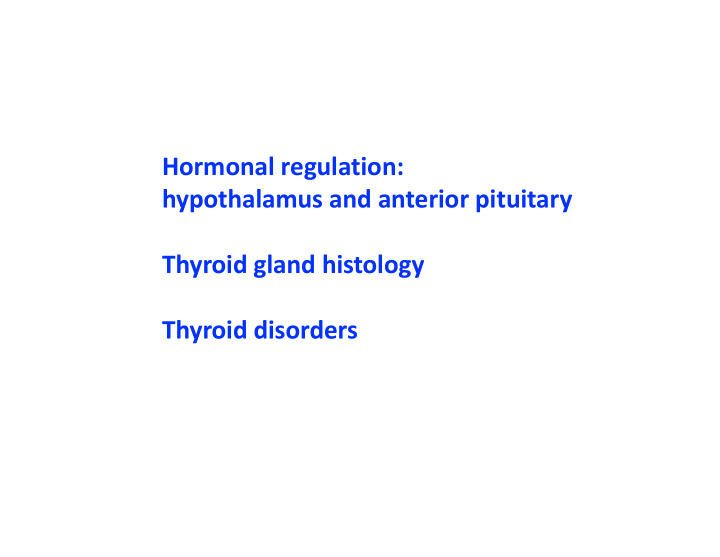



Hormonal regulation: hypothalamus and anterior pituitary Thyroid gland histology Thyroid disorders
Signaling by regulatory molecules hormones travel via the circulatory system to their targets • may travel long distances to reach their targets • may have systemic effects (multiple targets) •
Hormonal signaling: polar hormones * • most hormones are polar hormones • most hormones are polypeptide hormones *receptors are often G-protein coupled receptors • (insulin, glucagon, amylin, secretin, CCK, GLP-1, GIP, vasopressin, gastrin, somatostatin, leptin, PYY, ghrelin, a -MSH, oxytocin, GnRH, FSH, LH, CRH, ACTH, TRH, TSH, prolactin, GHRH, GH, IGF-1, calcitonin, parathyroid hormone)
Hormonal signaling: nonpolar hormones longer time course of action • hormonal action involves changing gene expression • hormones modified by enzymes at target cells •
Nonpolar Hormones Steroid hormones estrogen progesterone testosterone aldosterone cortisol Vitamin D (1,25(OH) 2 D) Thyroid hormones triiodothyronine (T3) thyroxine (T4)
The pituitary gland is situated below the hypothalamus, posterior to the optic chiasm midsagittal view of brain enlarged view H optic stalk of chiasm pituitary gland H: hypothalamus à Be able to identify stalk of pituitary gland and hypothalamus
Location of pituitary gland within the skull Figure 8.213B, Gray’s Basic Anatomy pituitary gland midsagittal view of nasal cavity showing pituitary gland inside the head model in library sella turcica and adjacent to the sphenoid sinus sphenoid sinus
There are two parts to the pituitary gland: anterior pituitary and posterior pituitary A P Figure 7.8a, p. 208 A à anterior pituitary (adenohypophysis): glandular pituitary P à posterior pituitary (neurohypophysis): axons and terminals of neurohormonal cells with cell bodies in the hypothalamus hormones of the posterior pituitary: oxytocin and vasopressin
Hormones regulated by the hypothalamus and pituitary hypothalamic hormones: stimulatory: GnRH, GHRH, TRH, CRH inhibitory: dopamine, somatostatin anterior pituitary hormones: FSH, LH, TSH, GH, ACTH, prolactin peripheral gland hormones: gonadal steroids (estrogen, progesterone, testosterone), thyroid hormones (T3 and T4), IGF-1, cortisol
Hormonal regulation of hormone release for a nonpolar hormone: for a polar hormone: tropic hormone: a hormone that regulates hormone secretion by another endocrine cell • tropic hormones may also stimulate growth of endocrine tissue • NOTE: some texts (such as Silverthorn) use the term “trophic hormones”
Hormone-releasing cells in the hypothalamus are neurosecretory cells
Connection between the hypothalamus and the anterior pituitary: hypophyseal portal vessels neurosecretory cells releasing hypothalamic hormones capillary bed at base of hypothalamus hypophyseal portal vessels capillary bed in a portal vessel links two capillary beds • anterior pituitary the hypophyseal portal vessels provide a • restricted vascular link between the hypothalamus and the anterior pituitary Adapted from Figure 7.8b, p. 208
Connection between the hypothalamus and the anterior pituitary: hypophyseal portal vessels
Negative feedback regulation of hormone release for hormones regulated by the anterior pituitary peripheral gland hormone binds to its receptors in the hypothalamus and anterior pituitary to inhibit secretion of tropic hormones à helps keep hormone secretion within the appropriate physiological range
Hormones regulated by the hypothalamus and pituitary hypothalamic hormones: stimulatory: GnRH, GHRH, TRH, CRH inhibitory: dopamine, somatostatin anterior pituitary hormones: FSH, LH, TSH, GH, ACTH, prolactin peripheral gland hormones: gonadal steroids (estrogen, progesterone, testosterone, thyroid hormones (T3 and T4), IGF-1, cortisol
Regulatory sequences for hormones thyroid sequence cortisol sequence reproductive sequence
The thyroid gland is located in the neck
Synthesis of thyroid hormones, T3 and T4 Adapted from follicle cells synthesize T3 and T4 • Figure 23.4, p. 735 iodine is required for active T3, T4 • T3 and T4 are synthesized as part • of a protein precursor called thyroglogulin
Histology of the thyroid gland thyroid follicles: spherical structures consisting of a simple cuboidal epithelium made up of follicle cells, surrounding a central region filled with thyroglobulin
Thyroid follicles thyroglobulin follicle cells
T3 and T4 are nonpolar hormones e.g. deiodinase T4 is main hormone produced by thyroid gland • T3 is active thyroid hormone • deiodinase in target tissues converts T4 to T3 • T3 acts by changing gene expression in target tissues •
Thyroid hormone functions develpmental required for proper nervous system development • required for proper growth • adult increases resting energy expenditure: • increased synthesis and degradation • • increased expression of Na+/K+- ATPase • decreased efficiency of ATP synthesis in mitochondria cardiac effects • enhances sympathetic effects •
Iodine deficiency causes hypothyroidism and may cause goiter less active T3, T4 due to insufficient iodine in diet less feedback inhibition means more TSH secretion by anterior pituitary TSH stimulates growth in the thyroid gland to cause goiter Figure 23.6a, p. 738 goiter: enlarged thyroid gland Figure 23.7b, p. 738
Clinical example: hypothyroidism diagnosis is by made by measuring TSH levels • elevated TSH indicates hypothyroidism • primary hypothyroidism can by caused by • autoimmune destruction of thyroid gland (Hashimoto’s thyroiditis) treatment: thyroid hormone replacement •
Recommend
More recommend